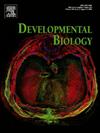在上胚层形成过程中,胚盘扩张和 AMOT 降解共同促进了 YAP 的核定位。
IF 2.1
3区 生物学
Q2 DEVELOPMENTAL BIOLOGY
引用次数: 0
摘要
上胚层是植入前胚胎囊胚晚期形成的多能细胞群。在从早期囊胚的内细胞团(ICM)形成上胚层的过程中,需要通过辅激活蛋白 YAP 的核转位来激活 Hippo 通路转录因子 TEAD,从而使多能因子得到强有力的表达。然而,在上胚层形成过程中改变 YAP 定位的机制仍然未知。在这里,我们揭示了两种这样的机制。胚泡的扩张通过增加细胞质 F-肌动蛋白和减少 YAP 磷酸化来促进 YAP 的核定位。此外,细胞分化也会调节 YAP。在上胚层形成过程中,连接Hippo成分AMOT的表达通过tankyrase介导的降解逐渐减少。ICM 中 SOX2 的表达是减少 AMOT 和 YAP 磷酸化的必要条件。这两种机制同时发挥作用。因此,在上胚层形成过程中,胚泡-F-肌动蛋白轴和 SOX2-AMOT 轴协同抑制 YAP 磷酸化并促进 YAP 核定位。这两种不同机制的合作可能有助于上胚层细胞分化的稳健性。本文章由计算机程序翻译,如有差异,请以英文原文为准。

Blastocoel expansion and AMOT degradation cooperatively promote YAP nuclear localization during epiblast formation
The epiblast is a pluripotent cell population formed in the late blastocyst stage of preimplantation embryos. During the process of epiblast formation from the inner cell mass (ICM) of the early blastocyst, activation of the Hippo pathway transcription factor TEAD by the nuclear translocation of the coactivator protein YAP is required for the robust expression of pluripotency factors. However, the mechanisms that alter YAP localization during epiblast formation remain unknown. Here, we reveal two such mechanisms. Expansion of the blastocoel promotes nuclear YAP localization by increasing cytoplasmic F-actin and reducing YAP phosphorylation. Additionally, cell differentiation regulates YAP. Expression of the junctional Hippo component, AMOT, gradually decreases during epiblast formation through a tankyrase-mediated degradation. SOX2 expression in the ICM is necessary for the reduction of AMOT and YAP phosphorylation. These two mechanisms function in parallel. Thus, the blastocoel–F-actin and SOX2–AMOT axes cooperatively suppress YAP phosphorylation and promote YAP nuclear localization during epiblast formation. The cooperation of these two distinct mechanisms likely contributes to the robustness of epiblast cell differentiation.
求助全文
通过发布文献求助,成功后即可免费获取论文全文。
去求助
来源期刊

Developmental biology
生物-发育生物学
CiteScore
5.30
自引率
3.70%
发文量
182
审稿时长
1.5 months
期刊介绍:
Developmental Biology (DB) publishes original research on mechanisms of development, differentiation, and growth in animals and plants at the molecular, cellular, genetic and evolutionary levels. Areas of particular emphasis include transcriptional control mechanisms, embryonic patterning, cell-cell interactions, growth factors and signal transduction, and regulatory hierarchies in developing plants and animals.
 求助内容:
求助内容: 应助结果提醒方式:
应助结果提醒方式:


